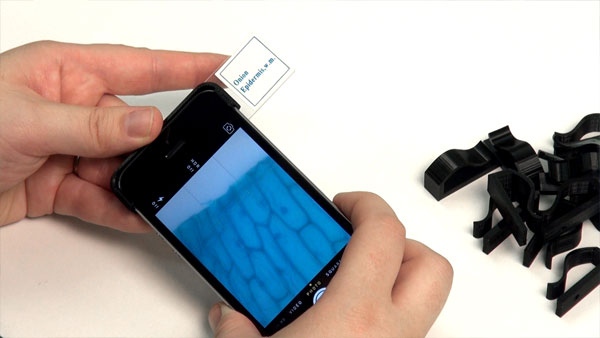
[Image above] A team from the Pacific Northwest National Laboratory has developed an inexpensive 3D-printed microscope that can attach to your iPhone. Above, the mobile microscope shows the epidermis of an onion at 350X magnification. Credit: PNNL
Need a more mobile microscope and have 10 minutes to spare?
Then you’ve got plenty of time to try your hand at printing your very own cell phone microscope at home.

Simulated anthrax spores are viewed on PNNL’s 3D-printed microscope. Credit: PNNL
A new “sleek, simple, and inexpensive” method developed by a Pacific Northwest National Laboratory team marries glass beads and 3D printing and can transform your smart (or dumb) phone into a portable high-powered, high-quality microscope in about the same amount of time it takes to delete U2’s newest album from your iTunes library.
How’d it happen?
Through the magic—and magnifying capabilities—of glass beads.
Yes, the glass beads that form the microscope lens are the same ones used in reflective pavement markings (click here to read an in-depth post by April on the subject). Though they may be tiny, they are capable of magnifying a sample 1000X.
This new approach, however, wasn’t intended for you and me—not necessarily, anyway.
Because it is easily printed, the glass-bead-based scope is ideal for those who work in more mobile (pun intended) situations—first responders investigating a mysterious substance, health workers who work outside a lab, or teachers and students who have a shortage of available microscopes. It’s also inexpensive to produce—the materials needed cost less than $1—purposely, researchers say, so that it can be thrown away should it be contaminated in the field.

The size of the glass bead lens determines the magnification of the microscope. The 100x version requires a bead with a 3mm diameter; the 350x versions require a bead with approximately 1mm diameter; and the 1000x version requires a bead with a 0.3mm diameter. Credit: PNNL
“We interviewed a lot of first responders, public health labs, and civil support teams,” says Cheryl Baird, PNNL biochemist in a lab news release. “They told us the first thing they do when a suspicious powder sample gets to the lab is to put it under the microscope. An inexpensive, yet powerful microscope in the field could be used to quickly determine whether the material is a threat or a hoax. Combine the microscope with the picture sharing capability of a smart phone and now practically anyone can evaluate a sample at the source and have a trained microbiologist located in a lab elsewhere interpret the results within minutes.”
According to the release, the 1000X magnification is capable of seeing the tiniest of pathogens, and versions with lower magnifications (350X and 100X) allow for viewing of protozoa in drinking water and investigation of more common items such as salt.
“We feel there are many uses out there, including human and veterinary medicine in developing countries,” says Janine Hutchison, PNNL microbiologist. “We are also excited about engaging kids in science. School districts have a hard time providing enough microscopes for students. Our science education staff is actively engaged in getting it into the hands of local school children this fall.”
The microscope fits most cell phones and tablets, including the iPhone (4 and 5 for now), Galaxy, and iPad.
You can watch the mobile phone-to-microscope transformation happen in the video below, or—in the words of the King of Pop—“just bead it,” aka, download the specs and print your own. (Protip: According to the lab, if you’re going to build one, you need to consider the size and clarity of the glass bead you’re using. The 100X version requires a bead with a 3 mm diameter; the 350X versions require a bead with approximately 1 mm diameter; and the 1000X version requires a bead with a 0.3 mm diameter. They also recommend that you find a bead that is as round and clear as possible. See the lens specs for more details.)

Credit: PNNL, YouTube
Author
Jessica McMathis
CTT Categories
- Basic Science
- Biomaterials & Medical
- Education
- Environment
- Glass
- Optics
- Weekly Column: “Other materials”


